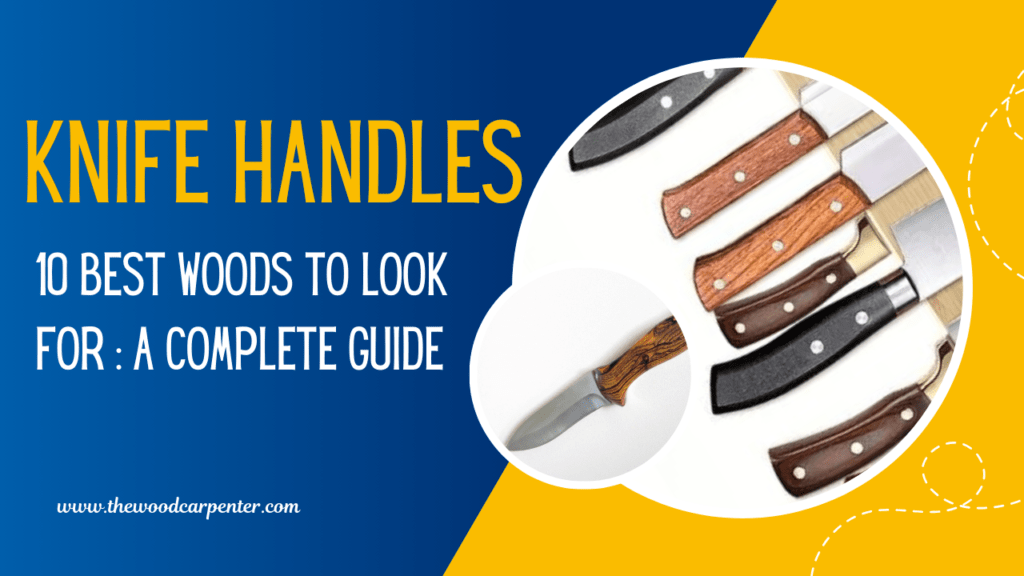
Reach for a knife and your fingers will curl around its handle, no matter how long it has been since your eyes admired the blade. And that’s the unseen power of a handle—it determines comfort, hands play in control of the knife and even how long it will last. And, as far as handle materials go, wood has had staying power like no other.
Even though we now have synthetics, carbon fiber, and G10 composite handles available, nothing beats wood handles for warmth, rich grain patterns, and centuries of craftsmanship. They simply can’t be replaced.
I will walk you through a comprehensive overview of 10 top woods for knife handles – their strengths, weaknesses, and what makes them so sought-after among knife makers and collectors alike. And I’ll pepper in some real-life care pointers and F.A.Q.s to guide you through the decision-making.
Why Choose Wood for Knife Handles?
Wooden handles provide that blend of beauty, sturdiness and history. From a hunter’s tough fixed blade to a chef’s favorite kitchen knife, the handle is more than just ornament – it is half of the experience.
Here’s why wood remains the favorite:
Grip and comfort: Over the time the wood naturally adapts to your hand over time.
Beauty: No two handles are alike – each piece of wood has its own story to tell.
Repairable: Unlike synths, wood handles are refinish-able/restore-able.
Tradition: For centuries, knife makers have chosen wood for its reliability.
Not all woods perform equally. While some naturally resist water damage, others require stabilization; and while some might be chosen purely for aesthetic reasons or toughness.
Let’s dive into the 10 best choices.
1. Ebony – The Dark Classic
When you see an ebony handle, readying to shave with, you can instantly feel that it is something special. It’s dark black and has a smooth feel that is preferred by people looking for the best quality knives.
I can still recall an old kitchen knife that belonged to my grandfather. The blade had lost its sharpness but the ebony handle? After decades of use, still shiny and unbroken.
Pros: Really hard, naturally water resistant, durable.
Cons: Heavy, expensive and difficult to mold.
Best For: High-end kitchen knives, collectors pieces, heirlooms.
2. African Blackwood – The Musician’s Choice
African blackwood is so rock-solid stable it’s a common choice for clarinets and bagpipes. You read that right —this wood really does sing. With a knife, it means durability while also resisting swelling in wet conditions.
Pros: Quite durable, usually stable in dimensions, not susceptible to moisture.
Cons: Extremely dense (hard on tools), expensive.
Best For: Custom high-end blades, survival knives, heirlooms.
3. Cocobolo – Nature’s Firework
If you’ve never seen a cocobolo handle, then it is hardly surprising that it is one of the most popular. Each piece, with its fiery orange and red streaks and draperylike folds of pale brown, looks as if nature had painted it by hand.
Pros: It is naturally oily, great resistance to water, and it has stunning colors.
Cons: Dust can cause irritation when shaping; expensive.
Best For: Hunting knives, outdoor carry, and knives meant to turn heads.
4. Bocote – The Bold Striped Beauty
Straight from Central America, bocote’s striking zebra-like striping makes any knife look like a piece of art. It’s dense, durable, and surprisingly workable despite its bold looks.
Pros: Gorgeous pattern, oily enough to resist water.
Cons: Can darken with age; not cheap.
Best For: Decorative knives, collectors’ pieces, conversation starters.
5. Rosewood – The Reliable Classic
Rosewood is a common choice in both furniture and instruments — and it looks just as natural when making knife handles. It’s inexpensive relative to exotics, and it combines durability with deep reds.
Pros: It is widely available, insect and moisture resistant, beautiful hues.
Cons: It can dry out if it is not cared properly; sanding dust may irritate.
Best For: Kitchen and pocket knives, mid-range custom cutlery or anyone who uses their knife regularly.
6. Walnut – The Craftsman’s Friend
If wood can be said to have a “friendly” aspect, walnut is it. Easy to work, abundant and warm in tone, it’s suitable for beginners and pros.
Firearms manufacturers have relied on walnut for centuries and knife makers do, too. This one has a good weight and is pretty too.
Pros: Lightweight, easy to shape, and has warm color.
Cons: Not as water resistant as exotics.
Best For: Kitchen knives, collector’s pieces, affordable custom projects.
7. Mahogany – The Underrated Workhorse
Mahogany may not scream luxury like the ebony, but do not underestimate it. Famous for its reddish-brown luster as well as workability, it has been a favorite in furniture and shipbuilding. On knives, it’s a striking combination of beauty and endurance.
Pros: It is Easy to shape, stable, resistant to rot, attractive color.
Cons: Not as hard as ebony or ironwood.
Best For: Kitchen knives, general-purpose outdoor knives, affordable customs.
8. Desert Ironwood – The Indestructible Legend
This one’s a beast. One of the hardest and most enduring woods on earth desert ironwood. I have held one bowie knife with an ironwood handle that felt like a natural extension of my arm—solid, balanced and beautiful.
Pros: Very dense, does not warp, impressive dark grain patterns.
Cons: Heavy, pricey, and tough to work with.
Best For: Hunting knives, heavy-duty outdoor blades, luxury customs.
9. Koa – The Hawaiian Jewel
Native to Hawaii, koa’s wavy chatoyance (a shimmering effect that changes in the light) makes it one of the most eye-catching woods. And it’s not just for show; koa is tough enough to withstand everyday use.
Pros: Beautifully shimmering grain pattern, strong and lightweight.
Cons: Rare and expensive.
Best For: Collector’s knives, decorative kitchen knives, gifts.
10. Stabilized Wood – Modern Durability
Sometimes, nature needs a little help. Stabilized wood is natural wood infused with resin, making it denser, more resistant to water, and it is less prone to cracking. The beauty of natural wood with the strength of synthetics—that’s why so many professional chefs swear by it.
Pros: It is long-lasting, moisture-proof, huge variety of colors and patterns.
Cons: Less “authentic” feel compared to raw wood.
Best For: Professional kitchen knives, everyday carry (EDC) knives, low-maintenance users.
How to make a knife handle from wood
How to Pick the Right Wood for Your Knife Handle
Choosing the right wood isn’t just about looks—it’s about use, care, and personal style. Here are three questions to ask yourself:
Where will the knife live?
Kitchen knives face the water daily → So go for stabilized wood, rosewood, or mahogany.
Hunting knives face rough outdoor use → So go for Desert ironwood or African blackwood.
What’s more important—beauty or toughness?
Beauty → Bocote, koa, cocobolo.
Toughness → Ebony, desert ironwood, African blackwood.
How much care are you willing to give?
Low maintenance → Stabilized wood or desert ironwood.
Hands-on care → Olive oil finishes on walnut or rosewood.
Caring for Wooden Handles
- Even the toughest wood benefits from a little love:
- Wash by hand only—never in a dishwasher.
- Dry immediately after use.
- Oil regularly with mineral or tung oil.
- Store in a cool, dry place to prevent swelling.
- With proper care, a good wooden handle can last for generations.
Final Thoughts
The right wood can transform a knife from a tool into a treasured companion. From the commanding darkness of ebony to the glowing warmth of mahogany, each type of wood has its own story, personality, and charm.
Whether you’re a chef, a hunter, or a collector, investing in the right handle wood means you’re carrying not just a knife—but a piece of nature’s finest craftsmanship.
FAQs About Knife Handle Woods
1. What is the strongest wood for knife handles?
For sheer density and toughness, desert ironwood and African blackwood are the best.
2. Which wood is best for kitchen knives?
Stabilized wood, rosewood, or mahogany—they resist the water and last longer.
3. Is walnut strong enough for a knife handle?
Yes. It’s not the hardest, but it’s lightweight, attractive, and perfect for everyday use.
4. Do wooden handles require maintenance?
Do wooden handles require maintenance?Absolutely. Oil them regularly and avoid soaking to keep them in shape.
5. What makes stabilized wood different?
It’s natural wood infused with resin, making it far more resistant to cracking, warping, and water damage.

